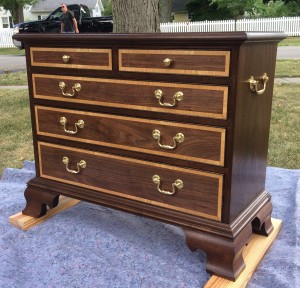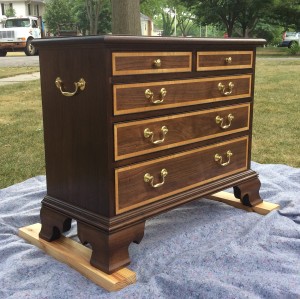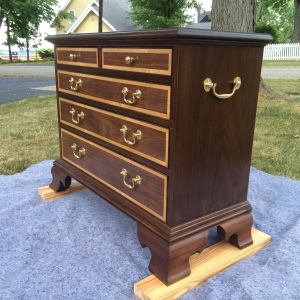Walnut COD – Done well before Christmas
I’m not just engaging in superficial anthropomorphism when I tell you that I’ve named this project “Morphy”. It’s been floating around here for so long that it’s become like a member of the family. I chose “Morphy” because during it’s short life it has gone from being one thing to quite another (more than once). But now Morphy is complete (except for shellacking the drawer interiors).
Morphy literally began as a set of feet. I had been intrigued by feet I had seen on a Georgian Secretaire. The sides were somewhat splayed which, I felt, made them look more “stream lined”. The splay is most evident when sighting across the resultant angle.
Morph’s feet are large. They would be better suited to a wider and deeper case, perhaps 48-54″ wide and 20″ deep (secretaire, chest on chest or a substantial bureau). Morph is more akin to a Bachelor’s chest, in stature. But remember, Morph started as a set of feet, proved to be far too deep for a bookcase then nearly became a TV stand before becoming a COD.
Morphy is more “period inspired” than period correct. While I did all of the joinery by hand, mouldings were built up from commercial router profiles. All of the casework parts were planed by hand as were drawer parts and backboards. That said, when it came to surfacing the top and drawer fronts, I called on Lester to come to my rescue. There’s just nothing like a 25″ sander, especially when you’re working up against a Christmas deadline.
I want to thank Jack Plane for his critique and suggestions as to top profiles. As you can see, I opted for the traditional “thumbnail and scotia”. I’d recommend that anyone with an interest in period furniture construction become very familiar with Mr. Plane and his excellent blog.
Explore posts in the same categories: Uncategorized
Tags: ogee bracket feet
You can comment below, or link to this permanent URL from your own site.



July 30, 2016 at 2:48 am
do you deliver , or must i come pick it up?
July 30, 2016 at 2:05 pm
And all this time I thought Morphy was going to be done last Christmes if not before.
July 30, 2016 at 6:11 pm
That’s a beautiful piece Dennis, even if it has big feet (ha ha). May I ask a question? I’ve been reading through your blog archives and in Feb., 2013 you listed many books in your collection. I’ve looked at some books from your list at the local library on furniture construction but can’t seem to find anything that has what I’m looking for, which is something that will show me varieties of plinths, carcases, tops, etc. Can you recommend something for one who is “less experienced”. Something that not only shows variations, but also some details of construction. Thanks.
July 31, 2016 at 1:15 am
In recent years most libraries have divested themselves of a lot of great texts on woodworking. There are, however, a number of wonderful reprints of texts from the late 19th and early 20th century that you might find helpful. You can find many important used woodworking books on Amazon, for very attractive prices. Several books that I think you’ll find very helpful are as follows: Modern Practical Joinery by George Ellis (reprint); Modern Cabinet Work by Percy A. Wells & John Hooper (reprint). If you are really interested in classical measurement and design, pick up a copy of Vitruvius. His observations still hold true after two millenia. Remember, you’re looking for information that is in the process of being lost. It’s a bit of a “wild goose” chase. But the more knowledge you gain, the more you’ll want. If you’re not already enamored with geometry, learn as much as you can. No “mistress” will ever serve you better. The craft is something that starts in your head and works its way out through your fingertips. Good luck. Stay in touch.
July 30, 2016 at 6:49 pm
Nicely done. What will become of Morphy?
July 31, 2016 at 12:59 am
Morph’s first job will be to provide a little more storage. His (or her’s) true worth will be recognized at the final estate sale.
July 31, 2016 at 3:00 am
Felicitations on the completion of Morphy. By the way, I’d keep an eye on that decidedly dodgy looking bloke in the first image above; he looks like he’d purloin Morphy in a heartbeat.
Now what’s all this nonsense about shellacking the drawer interiors?
July 31, 2016 at 6:21 pm
More often than not, I’ll leave drawer interiors “raw”. What’s your preference? For future reference, what have you found over the years in period pieces?
July 31, 2016 at 10:27 pm
In all my years restoring and dealing in sixteenth-, seventeenth- and eighteenth-century furniture, I have not encountered a single drawer whose linings were originally sealed in any shape or form.
Unfortunately, some ‘restorers’ take it upon themselves to ‘smarten-up’ tired looking drawer interiors for commercial purposes, but it’s a totally fallacious practice.
I can see no advantage in sealing drawer linings. If smoothly planed (traditionally, with a slightly radiused blade), the linings won’t attract dust and will glide effortlessly. Shellacked (or even waxed) linings can potentially cause a drawer to stick.
Rubbing a paraffin wax candle on the drawer runners is all the treatment I ever consider – and don’t always do.
August 1, 2016 at 4:07 pm
Thanks for the information, Jack. I feel better now, having left many drawers in their natural state and not having to “second guess” my decisions.